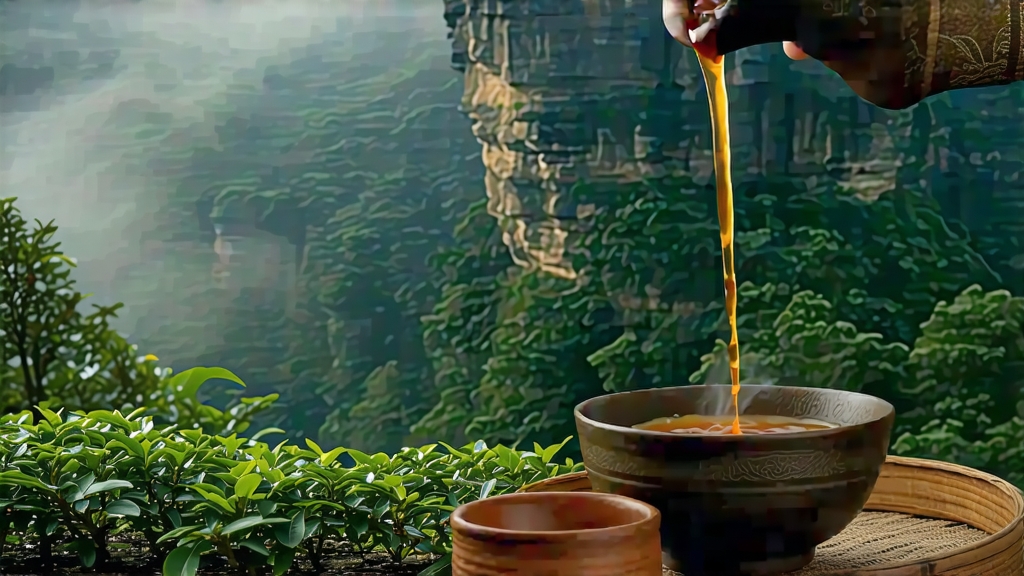
If green tea is the fresh-faced scholar of Chinese tea and pu-erh the bearded sage, then Da Hong Pao—Big Red Robe—must be the battle-scarred monarch who rules from the mist-veiled cliffs of northern Fujian. Its name alone evokes imperial crimson capes fluttering above the Nine-Dragon Gorge, yet the true throne of this oolong is hewn directly from the vertical granite of Mount Wuyi, a UNESCO dual World Heritage site where Taoist temples, 400-million-year-old rock formations, and micro-forests of tea share the same breath of mineral air. To understand Da Hong Pao is to listen to stone, fire, and time singing in concert.
Legend dates the birth of Da Hong Pao to the late Ming dynasty, when a scholarly candidate, en route to the capital examinations, fell gravely ill at the foot of Wuyi’s Tianxin Rock. Monks from the nearby Yongle Temple brewed leaves plucked from six scraggly bushes clinging to the cliff; the scholar revived, passed the palace exam with top honors, and returned in gratitude to drape his imperial red robe over those very bushes. Whether myth or marketing, the tale cemented the tea’s reputation as a life-restoring elixir. By the early Qing, Da Hong Pao had become tribute tea, traveling north in bamboo-lined crates along the same mountain trails that once carried cinnabar for the emperor’s seals.
Botanically, Da Hong Pao belongs to the Wuyi qi zhong (“strange cultivar”) family, a collective of indigenous bushes evolved on mineral-rich terraces. The original “mother trees,” six ancient plants still visible on Jiulongke cliff, have not been harvested since 2006 in order to protect their genetic legacy. Today’s market offers three legally recognized tiers:
- Purebred DHP—cloned directly from cuttings of the mother trees and grown inside the 60 km² Wuyi Scenic Reserve; yields are microscopic and prices astronomical.
- Rock-essence DHP—bushes of the same cultivar but planted elsewhere in the core Zhengyan (“true cliff”) micro-terroir, where daytime heat reflects off granite and nighttime mist delivers humidity.
- Garden DHP—high-quality cultivars such as Que She (“Sparrow Tongue”) or Bei Dou #1 grafted onto bushes outside the reserve yet still within Wuyi County; these provide the everyday drinker access to rock rhyme without auction-house drama.
The hallmark of Wuyi oolong is yan yun—“rock rhyme”—a sensory echo that begins in the nose as wet stone, expands across the palate as a metallic tingling, and lingers in the throat as a cooling, mentholated echo that can last twenty minutes. Achieving this requires a choreography of stress and mercy: bushes are planted so close to barren rock that roots must fracture granite to find water, concentrating minerals and polyphenols. Farmers purposely withhold irrigation during spring bud-break, forcing the plant to double its catechins and aromatic oils. The resulting leaf is small, leathery, and jade-dark, with a reddish edge that already hints at the oxidation to come.
Plucking takes place between late April and early May, ideally on foggy mornings when atmospheric moisture prevents premature withering. Two leaves and a bud are snapped with the fingernail, never cut, to keep cell walls intact for the bruising stage. Once back at the cottage, leaves are spread on bamboo trays set waist-high above smoldering pine charcoal; this “soft withering” lasts 30–40 minutes, just long enough for the edges to lose their brittleness while the veins remain too rigid to tear.
Next comes yao qing—“rocking the green.” The withered leaves are tumble-tossed into a rattan drum rotating at 18 rpm, a speed calculated to bruise 30 % of the leaf surface without breaking veins. Intermittent pauses allow oxidative enzymes to interact with air, turning the leaf rim a coppery red while the center stays olive. This on-and-off dance is repeated six to eight times across four hours, each cycle deepening floral lactones and unlocking a precursor called (E)-2-hexenal that later translates into peach-skin aroma.
When the leaf emits a sharp apple-cider note, the master halts oxidation at roughly 50 %—halfway between green and black. A 220 °C, 90